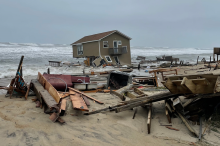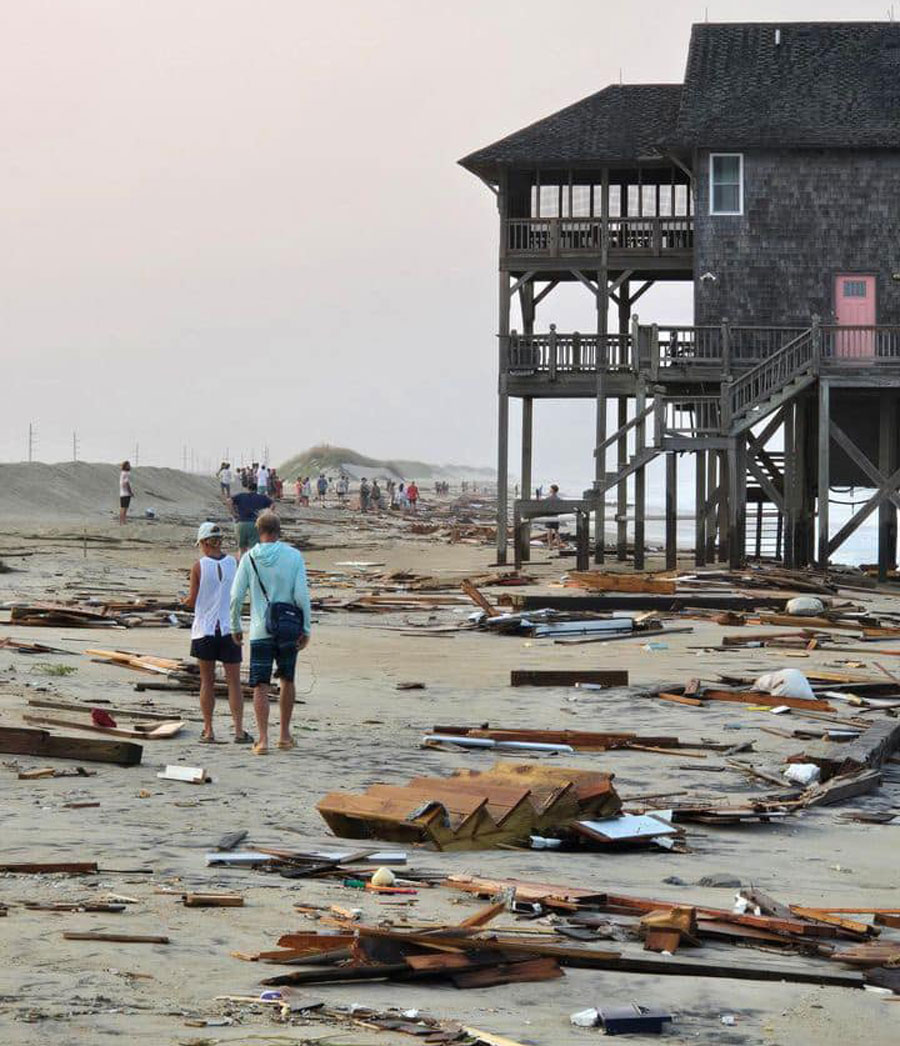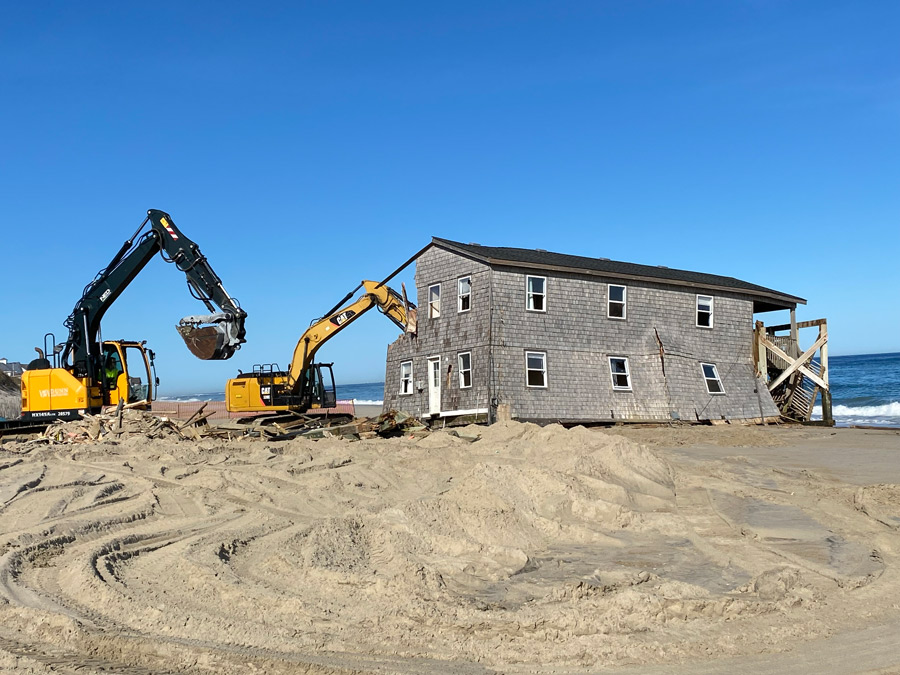
The Outer Banks is repeatedly making national news lately and not always for the best of reasons. While the Outer Banks beaches and towns are frequently ranked on national “Best” and “Top 10” lists, there’s another story that’s much more compelling to news media and national readers: beach houses falling into the ocean.
In the last four years, seven oceanfront houses in Rodanthe have washed into the Atlantic Ocean, and each time the story is reported far and wide. Just last week, on Friday, August 16, a house on East Corbina Drive was the most recent one to go. Beach erosion is a big problem in this area, and ocean swells from Hurricane Ernesto, which stayed well offshore, were the last straw for the 1,428-square-foot house. The house was unoccupied as it had been decertified for occupancy. Huge ocean waves swept under the house and washed out the pilings then the house just dropped into the ocean and floated before breaking apart in the waves.
Photo National Park Service
The previous six Rodanthe house collapses were in May 2020, February 2022, May 2022 (two in this month), March 2023 and May 2024. Each time this happens, it's a sad sight to see someone's beach house destroyed, but it creates dangerous house debris, everything from wood and nails to siding to furniture and trash, that spreads for miles. After a previous collapse, debris was found 20 miles away. The debris and septic runoff are damaging to the ecosystem and wildlife as well.
Cape Hatteras National Seashore, which manages all the Hatteras Island beaches and is part of the National Park Service, is forced to close beaches and urge people to stay out of the nearby waters until the site is sufficiently cleaned up.
This national media coverage of this situation has placed the small Hatteras Island village of Rodanthe, year-round home to around 200 people, right at the heart of climate change. It's a visible reminder of the threats of sea level rise.
Does this mean that all of the houses on the Rodanthe oceanfront are threatened?
No. These houses are in a small pocket of Rodanthe that faces especially intense erosion. There are hundreds of other houses in Rodanthe and thousands on the Outer Banks situated in safe areas.
Whether you see it online or in person, it’s shocking to see houses with ocean waves washing underneath the pilings and exposed septic tanks. And, believe it or not, the sight causes outrage among internet users who don’t understand the full situation. Commenters often complain that people should not be allowed to build so close to the ocean, but the fact is, the threatened houses were originally built on dry sand well back from the ocean and buffered by oceanfront dunes.

Debris on the beach from a house collapse on Corbina Street in Rodanthe on August 16. Photo: Chicamacomico Banks Fire and Rescue
What's causing this?
Part of the problem is sea level rise. The National Oceanic and Atmospheric Administration reports that climate change has caused sea level rise of about 6 inches in North Carolina since 2000. NOAA's 2022 Sea Level Rise Technical Report states that in the next 30 years, sea level is expected to rise 10 to 14 inches on the East Coast.
This area of Rodanthe also experiences intense beach erosion caused by the regular coastal storms and extreme weather events the Outer Banks experiences. In north Rodanthe, erosion rates have been measured at up to four meters per year — more than 10 feet of beach per year.
“The daily effects of winds, waves and tides, along with rising seas and storms, have played a part in contributing to coastal erosion impacts at Cape Hatteras National Seashore, particularly adjacent to Rodanthe and Buxton,” the Cape Hatteras National Seashore website says. “The effects of erosion in these villages have resulted in structures being present on the open beachfront on in the intertidal area, which may result in reduced beach access and safety for visitors, a loss of habitat for shorebirds and sea turtles and sometimes, structure collapse on beaches.”
What is being done?
Cape Hatteras National Seashore and Dare County are grappling with the issue of houses falling into the sea. A couple dozen more houses in Rodanthe and Buxton face the same fate, and the problem will only get worse in the future. NOAA reports that sea level rise could go up 1 foot by 2050.
Homeowners of threatened houses can preemptively move their houses to drier ground or pay to have their home demolished, but these are expensive options that most homeowners do not choose. So homeowners simply wait until the house collapses and seek insurance claims (yes, it seems the houses can be insured).
So far, there are no great solutions, though Cape Hatteras National Seashore is taking steps, ranging from contacting owners about cleanup, initiating volunteer cleanup efforts, implementing closures for visitor safety, communicating with owners about threatened homes, hosting public meetings and forming the Threatened Oceanfront Structures Interagency Work Group.

The National Park Service preemptively demolished two homes that were about to fall into the ocean in 2023. Photo: National Park Service
In 2023 the National Park Service piloted a program to purchase two houses that were in danger of collapse and hold controlled demolitions. Through a grant from the Land and Water Conservation Fund, the NPS was able to pay the owners fair market value for their homes. Using zero taxpayer dollars, the Fund invests earnings from offshore oil and gas leasing to protect lands and waters, preserve history and strengthen communities. However, funds only allowed for the purchase of two homes, but the NPS is evaluating the feasibility of a larger study.
To be sure, this will be an issue the Outer Banks will continue to face and it will be interesting to see what the solutions will be. For more information, visit Cape Hatteras National Seashore's Threatened Oceanfront Structures page.


 Molly Harrison is managing editor at OneBoat, publisher of OuterBanksThisWeek.com. She moved to Nags Head in 1994 and since then has made her living writing articles and creating publications about the people, places and culture of the Outer Banks.
Molly Harrison is managing editor at OneBoat, publisher of OuterBanksThisWeek.com. She moved to Nags Head in 1994 and since then has made her living writing articles and creating publications about the people, places and culture of the Outer Banks.

